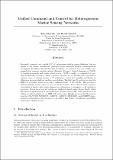| dc.contributor.author | Schmidt, Henrik | |
| dc.contributor.author | Schneider, Toby Edwin | |
| dc.date.accessioned | 2013-06-13T17:43:21Z | |
| dc.date.available | 2013-06-13T17:43:21Z | |
| dc.date.issued | 2010-11 | |
| dc.date.submitted | 2010-01 | |
| dc.identifier.issn | 1556-4959 | |
| dc.identifier.issn | 1556-4967 | |
| dc.identifier.uri | http://hdl.handle.net/1721.1/79099 | |
| dc.description.abstract | Successful command and control (C2) of autonomous vehicles poses challenges that are unique to the marine environment, primarily highly restrictive acoustic communications throughput. To address this, the Unified C2 architecture presented here uses a highly compressed short message encoding scheme (Dynamic Compact Control Language or DCCL) to transfer commands and receive vehicle status. DCCL is readily reconfigurable to provide the flexibility needed to change commands on short notice. Furthermore, operation of multiple types of vehicles requires a C2 architecture that is both scalable and flexible to differences among platform hardware and abilities. The Unified C2 architecture uses the MOOS-IvP autonomy system to act as a “backseat driver” of the vehicle. This provides a uniform interface to the control system on all the vehicles. Also, a hierarchical configuration system is used to allow single changes in configuration to propagate to all vehicles in operation. Status data from all vehicles are displayed visually using Google Earth, which also allows a rapid meshing of data from other sources (sensors, automatic identification system, radar, satellites) from within, as well as outside of, the MOOS-IvP architecture. Results are presented throughout from the CCLNET08, SQUINT08, GLINT08, GLINT09, SWAMSI09, and DURIP09 experiments involving robotic marine autonomous surface craft (ASCs) and Bluefin, OceanServer, and NATO Undersea Research Centre (NURC) autonomous underwater vehicles (AUVs). | en_US |
| dc.description.sponsorship | United States. Office of Naval Research (Grant N00014-1-08-1-0013) | en_US |
| dc.description.sponsorship | United States. Office of Naval Research (Grant N00014-1-08-1-0011) | en_US |
| dc.language.iso | en_US | |
| dc.publisher | Wiley Blackwell | en_US |
| dc.relation.isversionof | http://dx.doi.org/10.1002/rob.20346 | en_US |
| dc.rights | Creative Commons Attribution-Noncommercial-Share Alike 3.0 | en_US |
| dc.rights.uri | http://creativecommons.org/licenses/by-nc-sa/3.0/ | en_US |
| dc.source | Other Repository | en_US |
| dc.title | Unified command and control for heterogeneous marine sensing networks | en_US |
| dc.type | Article | en_US |
| dc.identifier.citation | Schneider, Toby, and Henrik Schmidt. “Unified Command and Control for Heterogeneous Marine Sensing Networks.” Journal of Field Robotics 27.6 (2010): 876–889. | en_US |
| dc.contributor.department | Joint Program in Oceanography/Applied Ocean Science and Engineering | en_US |
| dc.contributor.department | Massachusetts Institute of Technology. Center for Ocean Engineering | en_US |
| dc.contributor.department | Massachusetts Institute of Technology. Department of Mechanical Engineering | en_US |
| dc.contributor.department | Woods Hole Oceanographic Institution | en_US |
| dc.contributor.mitauthor | Schneider, Toby Edwin | en_US |
| dc.relation.journal | Journal of Field Robotics | en_US |
| dc.eprint.version | Author's final manuscript | en_US |
| dc.type.uri | http://purl.org/eprint/type/JournalArticle | en_US |
| eprint.status | http://purl.org/eprint/status/PeerReviewed | en_US |
| dspace.orderedauthors | Schneider, Toby; Schmidt, Henrik | en_US |
| mit.license | OPEN_ACCESS_POLICY | en_US |
| mit.metadata.status | Complete | |
